Sail Away
“Are you guys going to do Sail Away or Wild Wind?” we shout down from the top of Hidden Tower where Todd has just led Wild Wind (5.9). They say it doesn’t matter to them and I say that we’d love to get on Sail Away, which is only partly true. Sail Away is 5.8- with lots of stars. Back home in Gunksland, stars mean “hard for the grade.” I’d love to get on Sail Away if I’m brave enough to lead it, good enough to lead it clean, and if it’s not going to scare me too much.
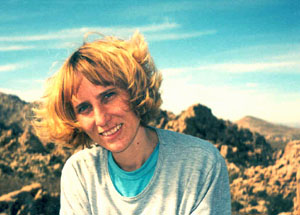
Me on top of Hidden Tower
While belaying Todd earlier I was listening to these two guys climb Sail Away, an exchange that might have frightened even less timid leaders than I.
“Just do it, dude! It’s like three moves of friction and you’re there. Don’t look around for holds–there aren’t any. You just gotta step up. Stick your foot anywhere. It’ll hold! See that jug up there? That’s what you’re going for. It’s bomber, dude. Go for it!”
Despite these assurances, the fearless leader refuses to progress.
“Come on, dude! Are you going to climb or are you just going to stand there? I’m not letting you down until you fall on that piece.”
Fearless leader is cajoled into stepping up.
“That’s it. Keep going. Don’t stop there! Two more moves. That’s it. Don’t look for gear. It’s like 5.5 the rest of the way. You gotta layback it. The holds are huge! Go! Go!”
The fearless leader returns triumphant, crediting his belayer for his success. I’m not so fearless, nor am I interested in quite so vehement a belayer, but I keep the lessons I have learned in mind as I prepare for my ascent. 1. the crux is friction, no holds but the gear will be close, just step up, it’ll stick and 2. above the crux I have to layback without placing any more gear, but it’ll be easy.
If you’ve led Sail Away, you’re probably already snickering, but let’s not get ahead of ourselves. My first hurdle is the start, which I decide to do directly since I can get gear in. I place a piece, get through all the hardest stuff, and have my foot come off as I start to step up on top of the big round lump. I catch myself easily but my heart starts beating wildly.
“Can you put in a second piece?” Todd asks. You know, I think I will put in another piece. But these moves are easy and then I’m in the crack and just sailing along (heh, heh, heh), jam, jam, jam, waiting for the crux to show up.
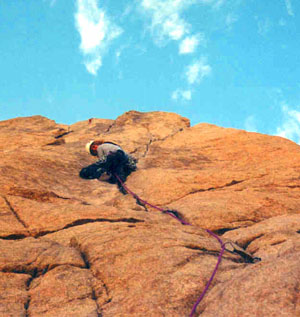
Me leading Sail Away (5.8-)
As I get near the top I feel the crux must be coming soon. I can see the spot where I can choose between going left and going right and I know the crux has to be before that. I start seriously sewing it up, placing a piece just about every move, wanting to have something in high when that gosh-darn just-go-for-it friction crux rears its ugly head.
Eventually I arrive at a move that seems a little harder, like maybe by half a grade. There’s no friction involved here. The crack never ends. I see a larger-than-average hold caked in chalk above me, which I assume is the “finishing jug”, but I’m disappointed by its slopey greasiness and put my fingers back in the crack instead. As for the 5.5 layback, it just doesn’t happen. I take the left exit and don’t fall off it, unlike two of the last three people I watched climb the route. Did they substitute something easier for Sail Away while I wasn’t looking? The whole experience mystifies me.
“Maybe stars mean easy for the grade at Joshua Tree,” I suggest to Todd. But easy or hard and however you choose to do the crux, Sail Away is a beautiful line, well worth doing and nicely protected.
Coulda, shoulda, woulda
If I can sail (heh, heh, heh) up a classic 5.8-, I ought to be able to make my way up this short, relatively unknown, extremely straightforward 5.8 called Right Sawdust Crack at Trashcan Rock, right?
I could have done it too. It’s a short route right off a block, so every piece of gear is vital and my habit of sewing it up isn’t overkill, but only common sense. It’s steep right from the start, much steeper than Sail Away, and wider too, but I could have done it if there hadn’t been this section where the crack opens and flares. If you climb at Joshua Tree, you know what I mean. Suddenly the lovely crack you’ve been using for both jams and gear becomes unuseable for either, leaving you feeling a bit stranded.
But I could have done it anyway if it weren’t for the fact that the first piece I fired in was not quite bomber, being a little tipped out from the flare.
I still could have done it, but unfortunately the second piece I placed was way too over-cammed, not a good piece at all, so it had to come out, not so easy to do what with it being over-cammed and all.
But I still could have done it, except that when I get the second cam wiggled back out, and I’ll bet this has never happened to you, it turns out that I’ve somehow clipped the biner from the first cam through the trigger from the second.
That’s when I panic.
I can’t just leave it like that – I have visions of the rope being cut by the trigger wires – and I only have one hand to work with. Five minutes of cursing and fumbling later, I manage to disentangle the two cams from each other and say “take”.
Other than that, I could have done it.
Double Cross
Almost since the day we booked our tickets, Todd has been asking me if I’m going to lead Double Cross (5.7+), the infamous newbie slayer of J-Tree legend. Don’t you just hate leading a route everyone tells you you’re going to die on? I’m feeling pretty dubious until I read one guidebook’s description that “unprotected easy climbing leads to a ledge from which the leader must place adequate protection.” Aw, shucks. I can place adequate protection from a ledge. I’m a Gunk’s climber for heaven’s sake. Ledges are my home turf and adequate protection is my middle name.
My answer, all along, has been, “If we can get on it. I’m not going to stand in line for it.”
So where’s the bloody line? The leader from the previous party is nearing the top as we arrive, allowing me only enough time to brood but not enough time to back out. I watch his second start up. Interesting. This unprotected start doesn’t look all that easy. It doesn’t look 5.4 easy. And you call that thing a ledge? I call that a dip in the rock, a depression, a bowl, a dish, but not a ledge.
The previous leader has one piece – a cam – in at the start of the crack and, personally, I don’t like the looks of it. The crack flares at the bottom. The point at which the crack becomes a good gear-eater is obvious. It’s also obvious that the crux is below that.
But I’m doing it.
I sketch my way through the unprotected start. It’s not as easy as I’d like but at least it isn’t any harder than 5.7+. I stand on the “ledge” and survey my options. Although the crack is too flaring for solid cam placements, it has some nice constrictions. I place two beautiful nuts. I survey some more. Below the nuts, under an overlap to the left, I place a cam, more to protect the nuts than to protect me. I feel good. Double check, this is Double Cross. Yes, I feel good.
I make the first few tricky moves and then it’s smooth sailing (heh, heh, heh – oops! wrong route) from there. Another classic route that deserves the distinction, and another one I’m glad I led. I suspect that if people are hitting the ground from Double Cross it’s because they’re forcing in cams where nuts should go.
Spot the mistake
Todd has his eye on Left Ski Track (5.11) across the way. Well, who wouldn’t? It’s a gorgeous looking line. It’s also got the crux at the bottom and poor looking protection opportunities where you need them most. So we shift over to Lower Right Ski Track (5.10b) which not only has the crux higher up but has a bolt protecting it as well.
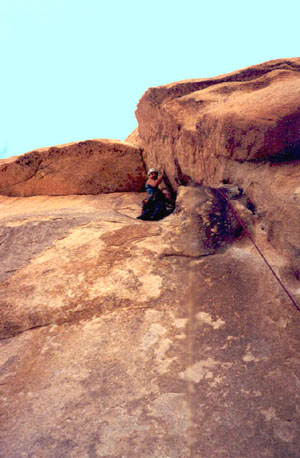
Todd leading Lower Right Ski Track (5.10b)
Todd gets the bolt clipped from a crazy-looking stance, then shifts and manages to fire in a #4 Camalot into a pod as a backup. What can I say? We’re trad climbers. He ends up hanging (but not on the bolt! as he insists) before firing through the longish crux, even managing to get another piece in along the way. I ask him to lower off because I want him to be able to give me an attentive belay and beta as I go. This turns out to be a mistake later, but for now I get the beta I need when I need it . . .
“Left! Left!”
“I can’t.”
But I try anyway and get it and pull through over the bulge onto the stance above the crux. The climbing above the crux is relatively easy stemming but I’m tired and it feels like I could come off with every move. Having gotten the crux clean, the last thing I want to do is fall off the easy stuff above it.
Todd decides he wants to take another burn on it as I’m climbing – I guess this was the real mistake – so I leave some gear in as I go. I pull through the last roof traverse problem, another pumper, onto the easy ground where people rapping down from above land. I start to remove the two pieces he has in at the roof.
“Leave those in,” Todd says. “They’re keeping the rope from getting wedged into the crack.”
I put back the nut I’d just pulled out. It’s too small, really, kind of wobbly, so I just lay it in there (this then is the mistake) and lower off. Just before I get back to the crux, the rope stops. The nut above me has shifted such that the rope and nut are now jammed in the crack together. No amount of yanking from either side will free them, not even after I climb back up a few moves.
Now what? I can’t get down and I’ve already got slack in the system from moving up. Out come the prusiks. Feeling sketched, I use a prusik cord to tie a prusik knot instead of using one of the runners to tie something sensible like a kleimheist. Now this is the mistake. It’s serious overkill. There’s no way the knot is moving on its own. After every couple of moves I have to stop, grab the rope with my teeth, and drag the prusik up the rope until it’s taut again. Even when I get back up to the final roof I can’t free the rope and have to make those last wild moves self-belayed.
Overhangs
Another classic is Overhang Bypass (5.7). After having just been as scared as I’ve ever been while on top-rope, I’m ready for something a little more casual.
“Just enjoy this,” I tell myself. “No fear, no panic. At 5.7, it’s the easiest thing you’ve tried to lead so far. Have a good time on it.”
And I do. Up to a point. Holy cannoli! This one move, coming out of the notch, is stinking hard. Can this be the way to go? The book suggests I should pull the roof straight up but common sense is telling me no. There’s no chalk up there for one thing. The chalk, and the gear, both head left. I put a piece out left and cautiously try the crazy move. I step back down and put another piece in even farther left and try again. I step back down and shorten the runner on one of the pieces. This is stupid, I know. It’s only going to save me a few feet of fall and it’s going to kill me with rope drag later, but it does the trick at least. I pull through the off-balance, layback, arete humping, corner turning move and, with my feet on the gear, discover that there’s no more gear straight up. Stinking “easy” friction. No way, buddy. I scootch left some more to a crack, which turns out to be so easy that I don’t end up putting any gear into it, and dance up to the belay under the overhang that gives the route its name.
As I’m belaying Todd, heaving up the rope made heavy by that short runner, I eye the second pitch of the route. I can do that. I have each move figured out – big jugs, big feet, plenty of gear. Then Todd says he wants to lead it. I’m disappointed, but relieved to discover that I’m not relieved. Because I’m not grateful that I don’t have to lead it, I don’t have to lead it. When my turn to follow comes, I realize I’m pretty much leading it anyway. In fact, he had gear closer to him for the one tricky move than I did.
We rap down to the rap landing and suddenly Todd wants to lead North Overhang (5.9). Oooh. Now I’m grumpy. If he was going to do his own Overhang pitch, then he shouldn’t have gotten to lead one of mine. He offers me the lead. Yeah, right. There may be bolts at the roof but there’s plenty more climbing on this route and no one there to guarantee that only the bolted part is 5.9. Would have served him right though.
As it turns out, only the bolted part is 5.9. As it turns out also, the route is seriously hard 5.9. You might have thought grades for J-Tree roofs would seem a little soft to us, given that we come from the land of the roof, but there hasn’t been any sign of that so far. Let’s just say that we both made it through by the skin of our teeth.
Clean and Jerk
Every once in a while, through the ups and downs of climbing, there comes a moment when theoretical progress manifests itself in a flash of reality. Clean and Jerk (5.10c) was one of those times. I’m not good enough, strong enough, tall enough, to climb Clean and Jerk, with its long, powerful moves and sustained climbing, cleanly. But I did.
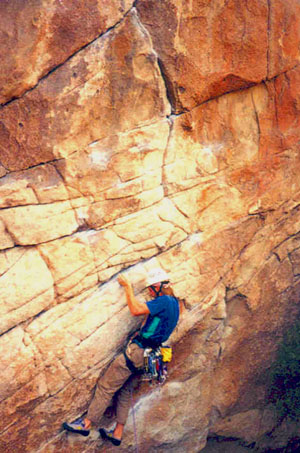
Justin leading Clean and Jerk (5.10c)
Lost Horse
For our last day of climbing we head into Lost Horse looking for the Shorter Wall, both because we’re trying to get away from the crowds and because we expect to meet friends there. I rack up to lead Swiss Cheese (5.6) which Julie has just led. There are two routes here, but the guidebook only shows one.
“I think Swiss Cheese is actually the left one,” Dave says, “but, whatever, it was pretty 5.6.” The right route has more bolts and looks easier so I take a smaller version of our normal rack and start up it. Somewhere near the top, protected by bolts that are close together even by sport climbing standards, I get major willies. The moves are longer than they looked from the ground and the edges on those swiss cheese-like holes are less positive than they appeared. Maybe I’ve just got my trad lead head on too firmly, but I move slowly and uncomfortably through the final moves and top out with a sigh of relief.
“When someone has just led a route, and they say it felt hard for the grade, you should always agree with them just out of principle,” I tell Todd later, after a bit of a sulk. He offers that the moves were “tricky” but won’t go so far as “hard.” Mumble mumble 5.10 climbers. Think everything under 5.9 is 5.6 Bet they can tell the difference between 10b and 10c alright.
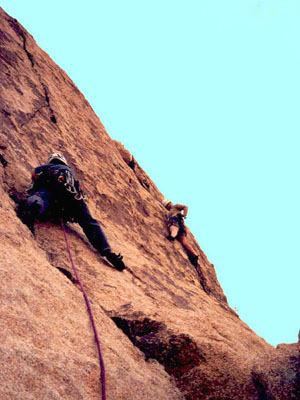
Todd leading Split Personality (5.9) in the foreground and Julie leading Beck’s Bet (5.8) in the background
I’m set up to lead Beck’s Bet, a two-tiered 5.8 hand crack, just contemplating the fact that I don’t like the first move already, when someone behind me asks, “Is that Dawn about to lead that crack?” Saved from the fearsome crack for the moment, I reach over and shake Jay’s hand.
“Back to your roots, huh?” Jay is right. Joshua Tree is where I learned to lead and where, after three days, I led my first 5.8. That was two years ago, back when I was a prodigy. Who knew then that two years later I’d still be struggling with 8s.
“I was a little worried about that,” I tell him. It’s been on my mind that I still haven’t led a second 5.8 at Josh, at least not cleanly. One day we stopped at Intersection Rock and looked up at the Flake, my first, and so far only, Josh 5.8. It was intimidating and I had no desire to try to repeat it.
I can’t dally with Jay long, not tied into the rope. The time has come to face my 5.8 du jour. I hoard my collection of #1, 2, and 3 cams as I go, placing anything else I can to save the precious hand sizes for later, going so far as to back clean such that I only leave one piece in the first half of the crack. When I get to the top I realize that I’ve still got most of them left on the rack and also that I’ve finally led that elusive second 5.8.
Smooth sailing indeed.
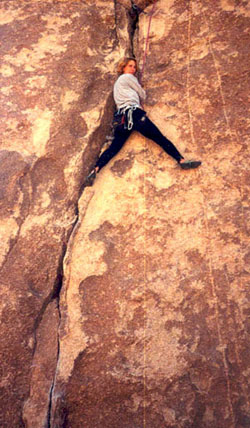
Me on Butterfly Crack (5.11c) at Trashcan Rock
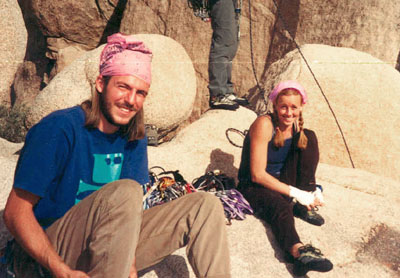
Justin and Melissa in their matching do-rags at Locomotion Rock
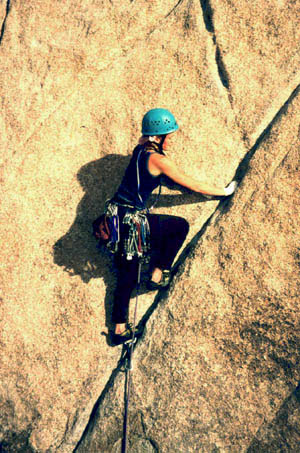
Melissa leading Leaping Leana (5.6)
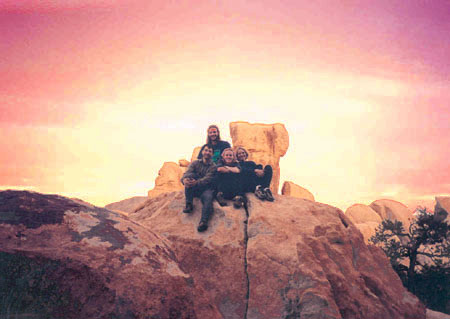
Todd, Justin, Melissa, and me behind Sports Challenge Rock
Leave a Reply